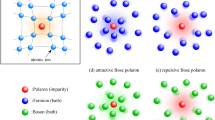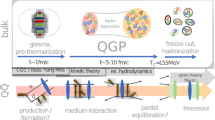The compressed baryonic matter (CBM) is intended for studying high-energy nuclear-nuclear collisions in the FAIR international heavy-ion facility. The objective of the experiment is to study the phase diagram of quantum chromodynamics at high baryonic density and at moderate temperature. The experimental problem is to identify hadrons and leptons and to record rare processes occurring in ion collisions under conditions with very high multiplicity of charged and neutral particles. More than 50 scientific centers are participating in the experiment. About 150 Russian physicists are participating in the work on almost all subsystems of the experiment.
Similar content being viewed by others
References
D. Roehrich, C. Aiftimiei, V. Catanescu, et al., Letter of Intent for Compressed Baryonic Matter Experiment at the Future Accelerator Facility in Darmstadt, The CBM Collaboration, Darmstadt, January 2004.
F. Sauli, “GEM: A new concept for electron amplification in gas detectors,” Nucl. Instrum. Meth. A, 386, 531–534 (1997).
R. Chechik, A. Breskin, and C. Shalem, “Thick GEM-like hole multipliers: properties and possible applications,” ibid., 535, 303–308 (2004).
Y. Giomataris, P. Rebourgeard, J. Robert, and G. Charpak, “MICROMEGAS: a high granularity position sensitive gaseous detector for high particle flux environments,” ibid., 376, 29–35 (1996).
S. Lebedev, C. Hohne, and G. Ososkov, “Ring recognition and electron identification in the RICH detector of the CBM experiment at FAIR,” J. Phys. Conf. Ser., 219, 032015 (2010).
A. V. Akimov, A. V. Akindinov, S. V. Boyarinov, et al., “Study of the characteristics and optimization of the parameters of a plane-parallel chamber used as a detector for time-of-flight measurements,” Prib. Tekh. Eksp., No. 5, 24–33 (2004).
V. Ammosov, I. Boyko, G. Chelkov, et al., “The HARP resistive plate chambers: characteristics and physics performance,” Nucl. Instrum. Meth. A, 602, 639–643 (2009).
A. Akindinov, A. Alici, P. Antonioli, et al., “The ALICE time-of-flight system: construction, assembly and quality tests,” Nuovo Cimento B, 124, 235–253 (2009).
A. Akindinov, A. Alici, F. Anselmo, et al, “A study of the multigap RPC at the gamma irradiation facility at CERN,” Nucl. Instrum. Meth. A, 490, 58–70 (2002).
A. V. Arefiev, I. M. Belyaev, B. M. Bobchenko, et al., “Study of the light collection in shashlyk-type calorimeters,” Prib. Tekn. Eksp., No. 4, 25–37 (2008).
M. Golubeva, F. Guber, A. Ivashkin, et al., “Longitudinally segmented lead/scintillator hadron calorimeter with micropixel APD readout,” Nucl. Instrum. Meth. A, 598, 268–269 (2009).
M. Golubeva, F. Guber, A. Ivashkin, et al., “Use of micropixel avalanche photodiodes for the readout of a lead/scintillator hadron calorimeter,” ibid., 610, 366–369 (2009).
Author information
Authors and Affiliations
Additional information
Translated from Atomnaya Énergiya, Vol. 112, No. 2, pp. 99–107, February, 2012.
Rights and permissions
About this article
Cite this article
Zaitsev, Y.M., Korolko, I.E., Kurepin, A.B. et al. Investigation of superdense baryonic matter during a collision of heavy ions (CBM Experiment). At Energy 112, 119–128 (2012). https://doi.org/10.1007/s10512-012-9533-6
Received:
Published:
Issue Date:
DOI: https://doi.org/10.1007/s10512-012-9533-6




